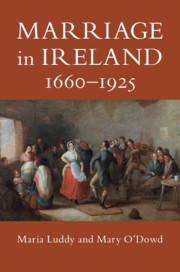Book contents
- Marriage in Ireland, 1660–1925
- Marriage in Ireland, 1660–1925
- Copyright page
- Dedication
- Contents
- Figures
- Illustrations
- Tables
- Acknowledgements
- Abbreviations
- Introduction
- Part I What Is a Marriage?
- Part II Ways to Marriage
- 3 Meeting and Matching with a Partner
- 4 Courtship Behaviour
- 5 Breach of Promise
- 6 Abductions
- Part III Happy Ever After?
- Part IV The Unmaking of Marriage
- Conclusion
- Select Bibliography
- Index
3 - Meeting and Matching with a Partner
from Part II - Ways to Marriage
Published online by Cambridge University Press: 04 June 2020
- Marriage in Ireland, 1660–1925
- Marriage in Ireland, 1660–1925
- Copyright page
- Dedication
- Contents
- Figures
- Illustrations
- Tables
- Acknowledgements
- Abbreviations
- Introduction
- Part I What Is a Marriage?
- Part II Ways to Marriage
- 3 Meeting and Matching with a Partner
- 4 Courtship Behaviour
- 5 Breach of Promise
- 6 Abductions
- Part III Happy Ever After?
- Part IV The Unmaking of Marriage
- Conclusion
- Select Bibliography
- Index
Summary
Chapter 3 explores how and where individuals met their future marriage partners. From the eighteenth to the early twentieth century there was a gradual expansion in the spatial range in which the search for a marriage partner took place.The move into towns and cities broadened the spaces for courtship.This chapter also looks at the ages at which people married and the changes that came about in age of marriage over the period. It reveals that from the seventeenth through to the early twentieth century, financial and material considerations formed a central part of the negotiations for the majority of marriages. Marriage was used by families as a means to accumulate additional economic resources or to retain land within a particular family. The size of a dowry could vary, depending on class, family income, and the numbers of daughters requiring a marriage portion.The perception that the dowry and arranged marriages became more pervasive in post-Famine Ireland is, however, not supported by the evidence. Dowries, whatever shape they took, made marriages an explicit business deal.Assets and the rights brought with them, provided the expectation of a wife’s control of her own household, the support of a husband and the safety of a family unit in which all might prosper.
Keywords
- Type
- Chapter
- Information
- Marriage in Ireland, 1660–1925 , pp. 91 - 134Publisher: Cambridge University PressPrint publication year: 2020

